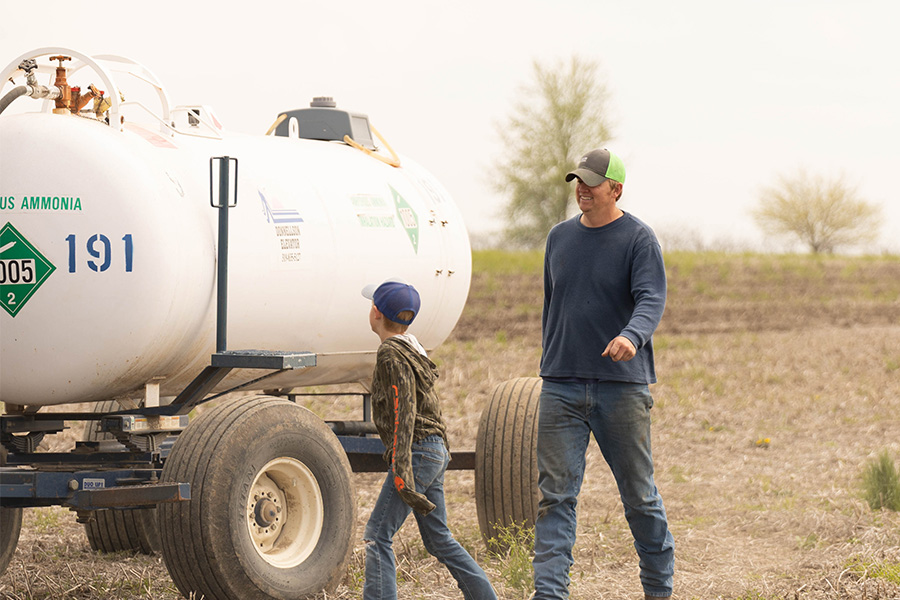
Opportunities are available to participate in ISA's fall trials including research on cover crops. (Photo: Iowa Soybean Association / Joclyn Bushman)
Farmers invited to participate in fall trials
August 24, 2023 | Kriss Nelson
The Iowa Soybean Association’s (ISA) Research Center for Farming Innovation (RCFI) team invites farmers to participate in fall trials.
Current trial opportunities include exploring cover crops, nitrogen and cropping systems.
While data collected will help understand new practices that can drive profitability and sustainability on your farm, that information will remain confidential.
Iowa Nitrogen Initiative
Nitrogen is critical in crop production but has become one of the most expensive inputs in recent years.
To help farmers understand their ideal nitrogen rates, the Iowa Soybean Association (ISA) has teamed up with Iowa State University (ISU) to conduct field trials through the Iowa Nitrogen Initiative.
“We are looking for farmers who have variable rate anhydrous capabilities that will be applying nitrogen this fall,” says ISA Research Agronomist Alex Schaffer, adding that the time to get signed up is now.
“We can work together to get the prescription ready while you are harvesting, so as soon as soils hit 50 degrees, you will be ready to implement the trial,” he says.
The goal is to collect hundreds of locations of five-rate nitrogen trials implemented via variable rate technology to improve the Maximum Return to Nitrogen (MRTN) tool and support various crop modeling and predictive models to improve farm profitability and nitrogen use efficiency.
ISA will use its network of research and conservation agronomists to help recruit farmers.
“Our goal is to increase recruitment with the Iowa Soybean Association being the single point of contact for the farmer,” says Joe McClure, director of research at ISA. “We will gather their information, partner with Iowa State University for the nitrogen prescription, and deliver the prescription and results back to the farmer.”
The only participation requirements are yield maps from previous years, a calibrated yield monitor, and access to equipment that can apply nitrogen at variable rates across the field.
Although yield maps will help to understand where a trial should be placed in the field, guidance from the farmer on areas yielding high and low, uniformly year after year, would also be sufficient.
Two block trials are placed in a field, and, considering past yield maps, trials will be put in consistently higher and lower-yielding field areas.
Five different nitrogen treatments will be within the block, all put on by a prescription by the Iowa Nitrogen Initiative team.
By participating in the Iowa Nitrogen Initiative, participants will receive annual results, guiding their practices from one year to the next.
For more information, contact Alex Schaffer, ISA research agronomist, at aschaffer@iasoybeans.com or 815-274-2998.
Improved Cropping Systems
ISA, Iowa Corn, and ISU are teaming up for a new trial opportunity on improved cropping systems.
ISA Research Agronomist, Scott Nelson says based on previous research, we have put together a cropping system that we believe will increase profitability while building soil and protecting water. We are asking farmers to dedicate between 15 to 25 acres in a trial to validate this new system.
In these validation trials, farmers are compensated for data and we provide key inputs such as a specially designed cover crop blend. The plot sizes are two to three rounds of the harvester at two locations in the field.
“We want to compare the improved system versus their standard practices to see if there is improved profitability or what we can learn about improving profitability on their farms,” says Nelson.
Farmers will also be paired with others with experience in making these improved cropping systems work and experts in crop management, including university and industry-leading agronomists.
Other farmer responsibilities include:
- Provide GIS data like as-applied and yield monitor data
- Contribute your ideas and experiences to trial methodology
Predicted merits of improved systems include:
- Eliminate costs of tillage
- Optimized nitrogen rates for your geography
- Increased nutrient use efficiency
- Simplified weed and disease management
- Greater soil tilth and reduced soil losses
- Improved yield stability in abnormal growing seasons
For more information, contact Nelson at snelson@iasoybeans.com or 515-334-1055.
Precision seeded cover crops ahead of corn
This RCFI project will look at precision seeding methods of a cover crop away from the planted corn rows to determine if there is a yield benefit n to the corn while overcoming the early season slow emergence and vigor of the corn plant, which is commonly seen with solid seeded cover crops. It is recommended that a blend of cereal rye and a legume or a brassica be used if possible.
“This trial will involve leaving a gap row while seeding the cover crop this fall where the future cash crop, in this case, corn, will be planted,” says McClure. “We understand the value of cover crops on the soil for erosion control and soil health while keeping room for the corn plant so it can thrive in the spring without competition.”
For more information, contact Joe McClure at jmcclure@iasoybeans.com or 515-334-1014.
Back